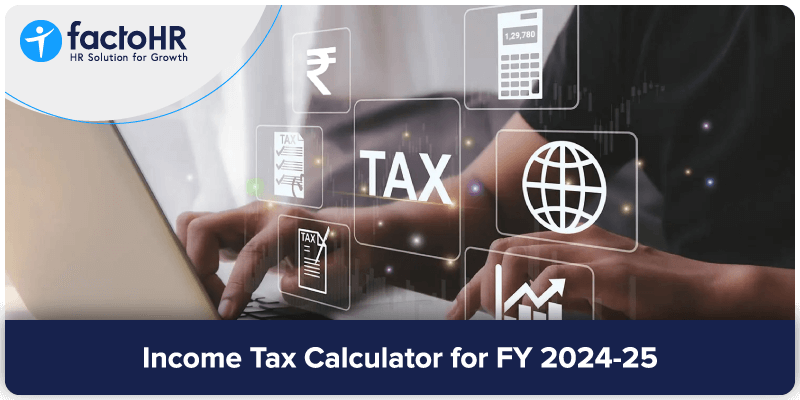How To Calculate Income Tax for FY 2024-25

Table of Contents
Nowadays, organizations use online payroll software for calculating and processing different kinds of taxes, including employees’ income tax. They can calculate employees’ taxes in bulk while maintaining the required statutory compliance. But that software is limited to organizations. Individuals can’t use that for calculating their income tax, that is where this article will help you to calculate income tax on your own.
What is An Income Tax Calculator?
An income tax calculator is a simple online tool to calculate income tax according to the current tax system in India. This calculator takes different inputs like annual income, Allowances, expenses, rent, EMIs on loans, and other tax deductions & exemptions, as well as tax-saving investments, to provide you with an estimated tax figure that you are liable to pay.
Whether you are an individual or a business entity, paying income tax from salary or other income is mandatory for all, and by using an income tax calculator, you can get an estimated amount for your income tax, which can be useful while filing for the income tax return.
Income Tax Calculator for FY 2024-25
| Income Details | |||
|---|---|---|---|
| Particular | Amount | Old Regime | New Regime |
| Exemptions u/s 10 A | – | NA | |
| Professional Tax | – | NA | |
| Total Income | – | – | |
| Deductions | |||
| Standard Deduction | – | NA | |
| Deductions u/s 80 C | – | NA | |
| Deductions u/s 80 CCD | – | NA | |
| Deductions u/s 80 D | – | NA | |
| Deductions u/s 80 G | – | NA | |
| Deductions u/s 80 E | – | NA | |
| Deductions u/s 80 TTA | – | NA | |
| Tax Benefit u/s 24 | – | NA | |
| Total Deduction | – | NA | |
| Tax Above Income | |||
Income Tax Slabs
Taxpayers in India pay taxes according to their income tax slabs. Tax slabs are different rates of taxes specified for different ranges of income. It means that tax is charged according to the amount of income one earns. If his/her income is high, then he/she is liable to pay more tax income compared to less who have less income. These tax slabs are likely to change during every budget.
- Individuals (below the age of 60)
- Senior citizens (between the age 60 to 80)
- Super senior citizens (age over 80)
These three categories have tax rate from 5% to 30% respectively, Contrary to that the new tax regime that has only one category that includes all age groups individuals but it has the same tax rate range, which is 5% to 30%. To get you a better understanding of tax slabs, here is a table showing all the tax slabs:
| Income Tax Slab | Existing Regime Slab Rates for FY 23-24 (AY 23-24) | New Regime Slab Rates for FY 23-24 (AY 23-24) | ||
|---|---|---|---|---|
| Resident Individuals & HUF < 60 years of age & NRIs | Resident Individuals & HUF > 60 to < 80 years | Resident Individuals & HUF > 80 years | Applicable for All Individuals & HUF | |
| Rs 0.0 – Rs 2.5 Lakhs | NIL | NIL | NIL | NIL |
| Rs 2.5 – Rs 3.00 Lakhs | 5% (tax rebate u/s 87a is available) | NIL | NIL | 5% (tax rebate u/s 87a is available) |
| Rs. 3.00- Rs 5.00 Lakhs | 5% (tax rebate u/s 87a is available) | NIL | ||
| Rs. 5.00 – Rs 7.5 Lakhs | 20% | 20% | 20% | 10% |
| Rs 7.5 – Rs 10.00 Lakhs | 20% | 20% | 20% | 15% |
| Rs 10.00 – Rs. 12.50 Lakhs | 30% | 30% | 30% | 20% |
| Rs. 12.5 – Rs. 15.00 Lakhs | 30% | 30% | 30% | 25% |
| > Rs. 15 Lakhs | 30% | 30% | 30% | 30% |
As you can see in the above table, there is a difference among the tax rates between old and new regimes, the tax rate in new regime is lesser than the tax rate in old regime. And now, you might wonder that why would anyone choose the old regime over the new regime, which has a comparatively lower tax rate? There is a simple yet complex reason for that. You should know that the tax rates are not the only thing that differentiates the new regime from old regime, another major components that changes in the new regime are deductions and exemptions.
The new regime may offer lower tax rates than old regime, but it takes away most of the deductions and exemptions that are offered in the old regime. For some people, that could be a major deal breaker because they heavily rely on the deduction & exemptions to reduce their tax amount. Hence, they choose to stick with the old regime despite knowing that the new regime has lower tax rates. And that’s something that you should also consider while choosing between the two regimes.

Exemptions & Deductions Allowed Under the Old Tax Regime
Earlier. We mentioned that the old regime allows major exemptions and deductions that could be helpful in reducing the tax amount. Through the following list, you can know what are the exemptions & deductions that are allowed under the old tax regime:
- House rent allowance & Leave travel allowance are tax exempted.
- Section 80C – Deductions up to ₹1.5 lakh on tax-saving investments.
- Section 80EE – Deduction on interest paid for home loans availed from any financial institution.
- Section 80G – Deduction on donations made to charity.
- Section 80E – Deduction on interest paid for educational loans for higher studies.
- Section 80GGC – Deduction on the contribution made towards any political party.
- Section 80D – Deduction on health insurance premium & medical expenses.
- Section 80TTA – Deduction up to ₹10,000 on the income earned from interest on savings account.
- All salaried individuals can claim for a standard deduction of ₹50,000.
Exemptions & Deductions Allowed Under the New Tax Regime
The new tax regime allows fewer deductions & exemptions compared to the old regime, but they are still useful for reducing the total income tax. Following are the exemptions & deductions allowed under the new tax regime:
- Section 80CCD(2) – deduction on employer’s contribution towards NPS.
- Tax exemption on interest earned and the maturity amount of the PPF Account and Sukanya Samridhi Yojana.
- Section 10(10D) – Tax exemption on maturity amount from a life insurance.
- Section 10(15) – Deduction on interest earned from post office savings account.
- Tax exemption on income received from leave encashment on retirement.
- Tax exemption if the individual opts for voluntary retirement.

How to Calculate Income Tax?
Calculating income tax is not very hard. If you have basic knowledge about tax calculations, then you can calculate your income tax on your own. You won’t need any professional to do it for you. The following steps will guide you through calculating your income tax on your own.
Step 1: Calculate your total gross income
You need to start by adding all your incomes from different sources like annual salary, income from interest, capital gain, income from rent, etc. but remember that HRA & LTA are tax exempted, so deduct HRA & LTA (if there is any) from total salary. Just for your knowledge, here is how the calculation will be done:
Total Gross Income = Annual salary – HRA – LTA + Income from other sources
Step 2: Calculate Net Taxable Income
This is an easy one, Once you get your total gross income, then just look at the tax slabs and find the one which is matching with your total gross income. Then calculate the amount of income that is taxable according to the tax slab, and you will get your net taxable income.
Step 3: Calculate Total Tax Benefits
As we have mentioned above, there are many tax deductions & exemptions to reduce the total tax amount, like tax-saving investments, insurance premiums, donations to charity, etc. if you have done any of them, then add them up, and you will get your total tax benefits amount.
Step 4: Calculate Total Tax Payable
Once you get your net taxable income and total benefits amount, then comes the final step of getting the exact tax payable amount. In this step, you need to deduct the total tax benefits from the net taxable income. Like this:
Total tax payable = Net taxable income – Total tax benefits
Now, to get you a better understanding of these calculation steps, we have written an example of income tax calculation:
Example
Nayan works in Delhi and gets a basic monthly salary of ₹80,000, he also gets HRA of ₹20,000 per month and a yearly LTA of ₹40,000. He stays in a rented house and pays rent of ₹15,000. His additional income from other sources is ₹2,00,000.
Now, let’s calculate his Gross taxable income from the above figures.
| Nature | Amount (annually) | Deductions/ Exemptions | Taxable Income (Old regime) | Taxable Income (New regime) |
|---|---|---|---|---|
| Basic Salary | 9,60,000 | 9,60,000 | 9,60,000 | |
| HRA | 2,40,000 | 84,000 | 1,56,000 | 2,40,000 |
| LTA | 35,000 | 35,000 | – | 35,000 |
| Gross income from salary | 11,16,000 | 12,35,000 | ||
| Standard deduction | 50,000 | -50,000 | – | |
| Income from other sources | 2,00,000 | 2,00,000 | 2,00,000 | |
| Gross taxable income | 12,66,000 | 14,35,000 |
We have got the gross taxable income for both the old and new regimes, but Nayan also took advantage of other tax deductions/exemptions, as he invested ₹1,50,000 in tax-saving Options under section 80C. Got a deduction of ₹30,000 under section 80D and made a donation of ₹40,000 to charity under section 80G.
Let’s deduct the deductions from gross income and compute the total tax payable.
| Old Tax Regime | New Tax Regime | ||||
|---|---|---|---|---|---|
| Gross Taxable Income | 12,66,000 | Gross Taxable Income | 14,35,000 | ||
| Total Deductions | 2,20,000 | Deductions | – | ||
| Total Taxable Income | 10,46,000 | Total Taxable Income | 14,35,000 | ||
| Income Tax Slab | Tax Rate | Tax Amount (In ₹) | Income Tax Slab | Tax Rate | Tax Amount (In ₹) |
| Upto ₹ 2.5 lakhs | – | – | Upto ₹ 2.5 lakhs | – | – |
| ₹ 2.5 lakhs to ₹ 5 lakhs | 5% | 12,500 | ₹ 2.5 lakhs to ₹ 5 lakhs | 5% | 12,500 |
| ₹ 5 lakhs to ₹ 10 lakhs | 20% | 1,00,000 | ₹ 5 lakhs to ₹ 7.5 lakhs | 10% | 25,000 |
| Above ₹ 10 lakhs | 30% | 13,800 | ₹ 7.5 lakhs to ₹ 10 lakhs | 15% | 37,500 |
| ₹ 10 lakhs to ₹ 12.5 lakhs | 20% | 50,000 | |||
| ₹ 12.5 lakhs to ₹ 15 lakhs | 25% | 46,250 | |||
| Above ₹ 15 lakhs | 30% | – | |||
| Total Tax | 1,26,300 | Total Tax | 1,71,250 | ||
| 4% Health & education cess | 5,052 | 4% Health & education cess | 6,850 | ||
| Total tax payable after 4% cess | 1,31,35/2 | Total tax payable after 4% cess | 1,78,100 | ||
As you can see in the above table, the income tax was calculated under both the new and old tax regime, and we can clearly see a difference between total tax payable amounts, even though the tax rates are higher in old regime still the tax payable was lesser than the new regime that’s because of the deduction benefits in the old regime.

Conclusion
See, calculating income tax wasn’t hard at all, we did it in just a matter of few minutes, and now that you have also learned it too, you can calculate your income tax yourself. And still, if you are having any difficulties regarding your CTC components, allowances, or TDS, then you can read our article on CTC structure.
Grow your business with factoHR today
Focus on the significant decision-making tasks, transfer all your common repetitive HR tasks to factoHR and see the things falling into their place.

© 2025 Copyright factoHR


